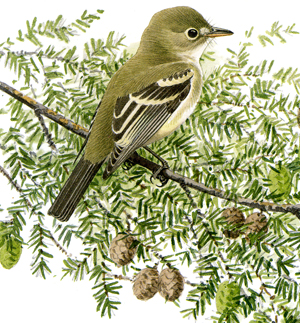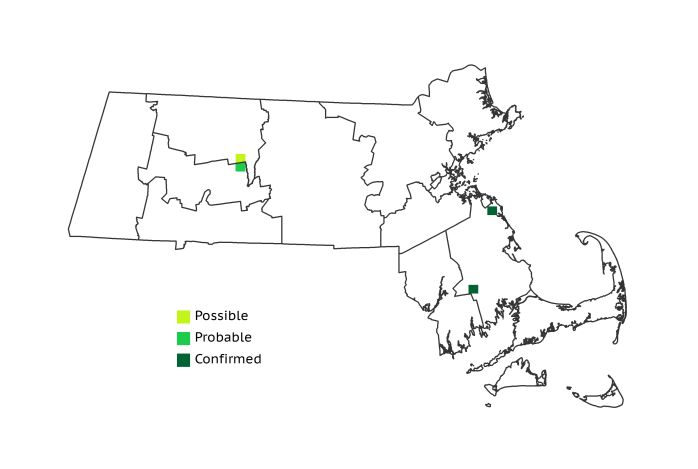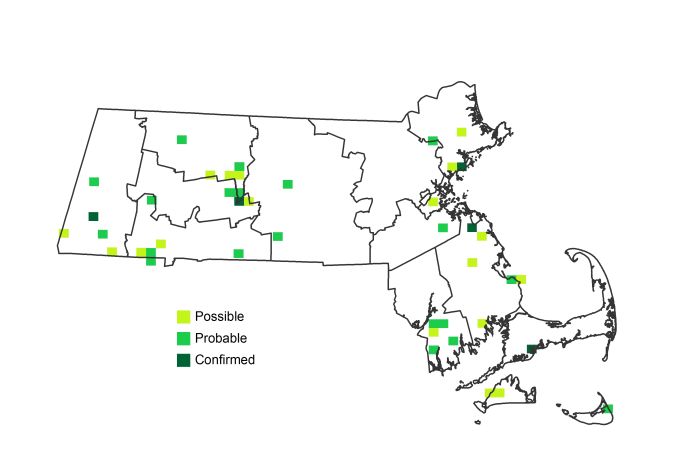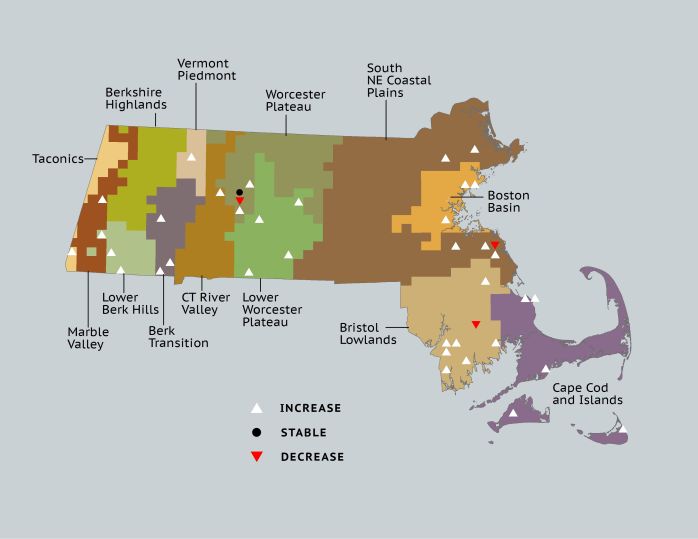Breeding Bird Atlases (BBA)
Find a Bird
Acadian Flycatcher
Empidonax virescens

Local and strongly increasing
“Professor Beal concludes that the Acadian Flycatcher is one of the birds whose function it is to keep down the great flood of insect life to a level ‘compatible with the best interests of other forms of life.’” – Edward Howe Forbush, Birds of Massachusetts and Other New England States
Though similar in appearance to their fellow Empidonax flycatchers, Acadian Flycatchers loudly proclaim their true identity with their distinctive song. The sharply whistled peet-sah! of this species is more incisive and considerably more recognizable than the songs of some of its close relatives. After a period of apparent historical abundance, Acadian Flycatchers became quite scarce in Massachusetts, but that trend seems to now be reversing itself. As moist forests of Eastern Hemlock and Red Maple grow to maturity throughout the Bay State, Acadian Flycatchers are finding new places to call their own.
Historic Status
Previously known as the Small Green-headed Flycatcher or Small Pewee, the Acadian Flycatcher was once a “very common summer bird” in Massachusetts, according to one 1839 report (Peabody 1839). Curiously, however, throughout the nineteenth century its breeding range seemed to retreat southward. Late century records were properly regarded as dubious resulting from ongoing identification issues among small flycatcher species. Although one nest was found in 1888 in Hyde Park, no Confirmed nests of this species were reported in Massachusetts until the 1960s (Veit & Petersen 1993). Ornithologists in Connecticut watched a similar scenario play out between 1900 and 1960 (Bevier 1994).
Atlas 1 Distribution
After a decades-long hiatus, the Acadian Flycatcher returned to breed in Massachusetts just before the Atlas 1 period. As a southern species with a predilection for wet forests, Acadian Flycatchers tended to be found in hemlock ravines in the Worcester Plateau, a region that accounted for 50% of the bird’s admittedly limited presence, though they were not Confirmed there. Acadian Flycatchers were only Confirmed breeding in the moist woods of southeastern Massachusetts, with one record each from the Coastal Plains and the Bristol/Narragansett Lowlands regions. Though they were otherwise absent from the Commonwealth, this toe-dipping presaged the reestablishment of the species as a regular breeder in the Bay State.
Atlas 2 Distribution and Change
Although still infrequently encountered, Acadian Flycatchers were much more widespread and were established breeders in Atlas 2. Formerly recorded in only 4 blocks, Acadian Flycatchers were found in more than 40 blocks scattered across the Commonwealth by the end of the second Atlas. The lower, wetter regions of western Massachusetts, such as the Marble Valleys and Lower Berkshire Hills, together had a handful of occupied blocks. There was also expansion around the Quabbin region at the interface of the Worcester and Lower Worcester Plateau zones. Much of the Coastal Plains region was totally devoid of breeding Acadian Flycatchers, but areas just north and just south of the Boston Basin region accounted for a scattering of blocks. The Boston Basin had a few blocks and one Confirmation of its own, but the largest number of new blocks in the state came from the Bristol/Narragansett Lowlands. Acadian Flycatchers were newly Confirmed on Cape Cod, and present on both Martha’s Vineyard and Nantucket.
Atlas 1 Map

Atlas 2 Map

Atlas Change Map

Ecoregion Data
Atlas 1 | Atlas 2 | Change | ||||||
Ecoregion | # Blocks | % Blocks | % of Range | # Blocks | % Blocks | % of Range | Change in # Blocks | Change in % Blocks |
Taconic Mountains | 0 | 0.0 | 0.0 | 1 | 4.0 | 2.3 | 1 | 6.7 |
Marble Valleys/Housatonic Valley | 0 | 0.0 | 0.0 | 1 | 2.6 | 2.3 | 1 | 2.6 |
Berkshire Highlands | 0 | 0.0 | 0.0 | 0 | 0.0 | 0.0 | 0 | 0.0 |
Lower Berkshire Hills | 0 | 0.0 | 0.0 | 4 | 12.9 | 9.3 | 3 | 11.1 |
Vermont Piedmont | 0 | 0.0 | 0.0 | 1 | 5.9 | 2.3 | 1 | 8.3 |
Berkshire Transition | 0 | 0.0 | 0.0 | 4 | 10.0 | 9.3 | 3 | 9.7 |
Connecticut River Valley | 0 | 0.0 | 0.0 | 1 | 1.5 | 2.3 | 1 | 2.1 |
Worcester Plateau | 2 | 2.6 | 50.0 | 5 | 5.7 | 11.6 | 1 | 2.1 |
Lower Worcester Plateau | 0 | 0.0 | 0.0 | 5 | 6.3 | 11.6 | 4 | 7.4 |
S. New England Coastal Plains and Hills | 1 | 0.4 | 25.0 | 5 | 1.8 | 11.6 | 4 | 1.8 |
Boston Basin | 0 | 0.0 | 0.0 | 3 | 5.4 | 7.0 | 3 | 5.5 |
Bristol and Narragansett Lowlands | 1 | 0.9 | 25.0 | 7 | 6.1 | 16.3 | 6 | 5.9 |
Cape Cod and Islands | 0 | 0.0 | 0.0 | 6 | 4.2 | 14.0 | 5 | 4.2 |
Statewide Total | 4 | 0.4 | 100.0 | 43 | 4.1 | 100.0 | 33 | 4.0 |
Notes
The Acadian Flycatcher shows a significant decreasing Breeding Bird Survey trend in the Eastern US overall. A factor to watch in the future that could potentially cause declines in Massachusetts is the spread of the Hemlock Woolly Adelgid scale insect on hemlock trees since Acadian Flycatchers are especially partial to nesting near brooks running through hemlock woodlands.



